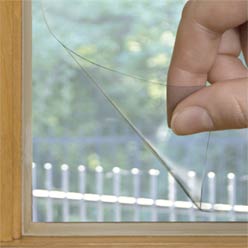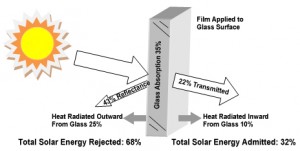 Windows can be both a blessing and a curse. Windows serve as both a means of escape and a way to enjoy the outdoors from within the home. Unfortunately the glass also provides a weakness in the insulation of your home. The glass allows heat, light, and chill to seep into the home. This could make your A/C and heater expend more energy to maintain a comfortable temperature. Homes without solar power will see an increase in their carbon footprint during drastically cold and hot months. In order to prevent this gain, homeowners need to increase the insulation of their windows.
Windows can be both a blessing and a curse. Windows serve as both a means of escape and a way to enjoy the outdoors from within the home. Unfortunately the glass also provides a weakness in the insulation of your home. The glass allows heat, light, and chill to seep into the home. This could make your A/C and heater expend more energy to maintain a comfortable temperature. Homes without solar power will see an increase in their carbon footprint during drastically cold and hot months. In order to prevent this gain, homeowners need to increase the insulation of their windows.
What is Window Film?
Window film is one possible insulation solution. It is created by bonding strong polyester and metallized coatings with adhesives. On one side of the window film is a scratch resistant coating, and on the other side is an adhesive layer protected by a release liner. When the release liner is removed, the window film is attached to the interior side of the glass.
Why Window Film?
Window film, such as shown in case studies by Vista Film, provides your windows constant regulation of heat and light allowed into your home. This will reduce your carbon footprint both directly and indirectly.
Direct Reduction of Your Carbon Footprint
Window film offers a year-round reduction in your carbon footprint by stabilizing the temperature of your home in both winter and summer. This means that your air conditioner and heaters will not need to work as hard to maintain a comfortable temperature. This reduction in heat and cold allowed into your home reduces the amount of energy used to regulate your home’s temperature—an especially important trait if you do not use solar panels to power your appliances and utilities.
In summer the window film reflects the solar radiation before it enters the home. This will reduce your heat gain up to 75%. In the past window film was not energy efficient in winter. While the capability of reflecting the sun’s rays is vital to summer energy efficiency, that ability can reduce the energy efficiency of your home in winter. Recent advances in window film production have coupled high reflectivity with high insulation. While windows with window tint will not be able to benefit from the sun’s rays, they will lock in up to 90% of the heat in your home. As long as your home well insulated, your window tint will reduce the energy consumed by your home in winter. This decrease in your carbon footprint might not be as much as in summer, but it will at least be an improvement over the previous year’s winter energy consumption.
Indirect Reduction of Carbon Footprint.
Window film also blocks ultra violet light from entering the home through your windows. Ultra violet light contributes to the decreased efficiency of your home. Constant exposure to ultra violet rays fades furniture, carpet, wallpaper, and wood. If you do not constantly use blinds or shades to prevent sunlight from entering your home, the constant exposure to sunlight could ruin your home’s interior way before you should have to renovate or replace damaged items. An environmentally inefficient habit due to the gas needed to ship the items and the energy required to build the items. Window film once applied provides constant protection for your furniture, carpet, wallpaper, and wood in your home.
The money saved on heating bills, cooling bills and replacing sun damaged furniture, can be used to improve other aspects of your life that are not as green as they could be. You could use that money to invest in a small solar power system or other green home projects. Just remember that the amount of heat and light blocked depends on the strength of the window film. For the most efficient windows, you should consider low-e window film. You should also ensure that the window film that you plan to apply to your home will increase your winter energy efficiency. Window film that offers high reflectivity, but not high insulation will waste money and energy in the long run.
Window film is only one choice to increase the efficiency of your home. If you do not believe that the film is the correct choice for your home, there is a myriad of other options to insulate your windows. Black out curtains, cellular blinds, weather stripping, and energy panels will all increase the insulation of your windows and contribute to a more efficient home.

 Artist’s Eichler Home Goes Green with Solar Energy and Foam Roof
Artist’s Eichler Home Goes Green with Solar Energy and Foam Roof Old Greenwich Home Project Reveals Surprising Benefits of Building with Styrofoam
Old Greenwich Home Project Reveals Surprising Benefits of Building with Styrofoam Three Tips for Buying Used Solar Panels for Pennies on the Dollar
Three Tips for Buying Used Solar Panels for Pennies on the Dollar
I’d be very interested in hearing how the film liners were developed. As in what their process is to create them. It’s very interesting how they work. If you could post an article on that, I’d read it for sure! Thanks for posting the information anyways!